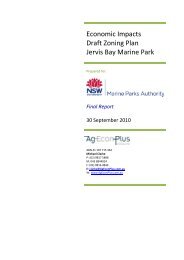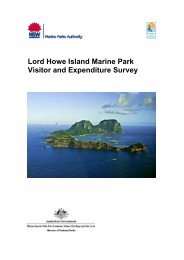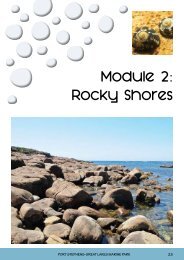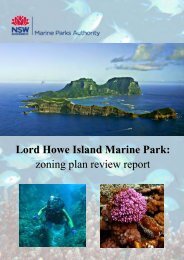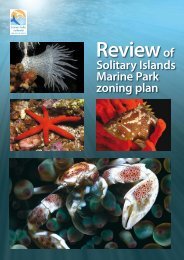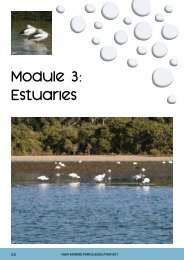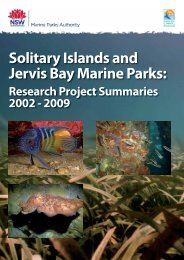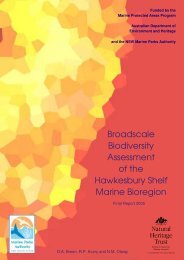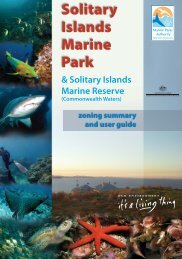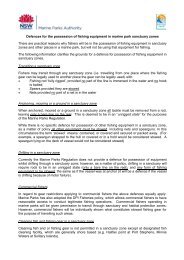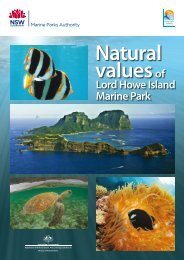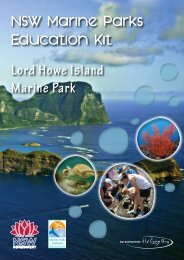Natural values of the Solitary Islands Marine Park - Marine Parks ...
Natural values of the Solitary Islands Marine Park - Marine Parks ...
Natural values of the Solitary Islands Marine Park - Marine Parks ...
- No tags were found...
You also want an ePaper? Increase the reach of your titles
YUMPU automatically turns print PDFs into web optimized ePapers that Google loves.
14 <strong>Natural</strong> <strong>values</strong> <strong>of</strong> <strong>the</strong> <strong>Solitary</strong> <strong>Islands</strong> <strong>Marine</strong> <strong>Park</strong>Figure 14.High resolutionbathymetric image <strong>of</strong> <strong>the</strong>seabed <strong>of</strong> 40 Acres Reef(Sidney Shoals) in <strong>the</strong>marine park.4.1.1 Inshore reefsThere are inshore reefs in much <strong>of</strong> <strong>the</strong> marine park, mainly adjacent to headlands thatalso contain intertidal rocky shores. Large inshore reefs occur between Jordans Creekand Moonee Creek, between Woolgoolga Headland and Arrawarra Headland, andbetween Station Creek and Wooli Wooli River. Smaller areas <strong>of</strong> reef occur adjacent too<strong>the</strong>r headlands and intertidal platforms (Figure 13). Reefs closer to shore are morecommon in <strong>the</strong> sou<strong>the</strong>rn half <strong>of</strong> <strong>the</strong> marine park.Like most shallow inshore reefs in NSW, reefs in <strong>the</strong> marine park are characterisedby abundant macroalgae (Millar 1990, 1998), dominated by <strong>the</strong> kelp Ecklonia radiata(Figure 16), and various species <strong>of</strong> Sargassum and Caulerpa (Smith and Simpson 1991a,Harriott et al 1994, Mau et al 1998). They generally contain an understorey <strong>of</strong> corallinealgae and a diverse range <strong>of</strong> foliose algae, including species <strong>of</strong> Zonaria, Rhodymeniaand Ulva (Kennelly 1995, Edgar 1997). There are also sponges and sessile invertebrates(those that attach <strong>the</strong>mselves to <strong>the</strong> seabed or o<strong>the</strong>r species) on shallow reefs, but<strong>the</strong>se are not generally <strong>the</strong> dominant assemblages.The species composition <strong>of</strong> algal assemblages is determined primarily by depth,exposure to swell, distance <strong>of</strong>fshore and patterns <strong>of</strong> recruitment and grazing, and<strong>the</strong>refore varies within and between reefs. Generally, throughout <strong>the</strong> marine park<strong>the</strong> cover <strong>of</strong> larger macroalgae decreases with distance <strong>of</strong>fshore (Harriott et al 1994).However, at any one particular site, <strong>the</strong>re may be zonation (particular distributions <strong>of</strong>species in zones).Barnacles and solitary ascidians (sea squirts), such as <strong>the</strong> pyurids Herdmania momusand cunjevoi Pyura stolonifera, can also be dominant on shallow exposed reefs, as canareas <strong>of</strong> bare rock with microalgal communities. Corals do occur on <strong>the</strong>se reefs butprimarily as a small component <strong>of</strong> <strong>the</strong> understorey assemblage. Some inshore reefshave specific <strong>values</strong> that are significant to <strong>the</strong> region. For example, <strong>the</strong> reefs fringingMuttonbird Island have high algal diversity, with occurrences <strong>of</strong> two rare endemicalgae species Valeriemaya maculata and Baldockia verticellata (Millar pers. comm.).



